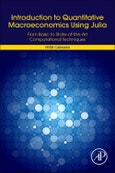Introduction to Quantitative Macroeconomics Using Julia: From Basic to State-of-the-Art Computational Techniques facilitates access to fundamental techniques in computational and quantitative macroeconomics. It focuses on the recent and very promising software, Julia, which offers a MATLAB-like language at speeds comparable to C/Fortran, also discussing modeling challenges that make quantitative macroeconomics dynamic, a key feature that few books on the topic include for macroeconomists who need the basic tools to build, solve and simulate macroeconomic models. This book neatly fills the gap between intermediate macroeconomic books and modern DSGE models used in research.
Please Note: This is an On Demand product, delivery may take up to 11 working days after payment has been received.
Table of Contents
1. Introduction to Julia 2. Basic Numerical Techniques 3. Solving and Simulating DSGE Models 4. Dynamic Programming 5. Advanced Numerical Techniques 6. Heterogeneous Agents Models








